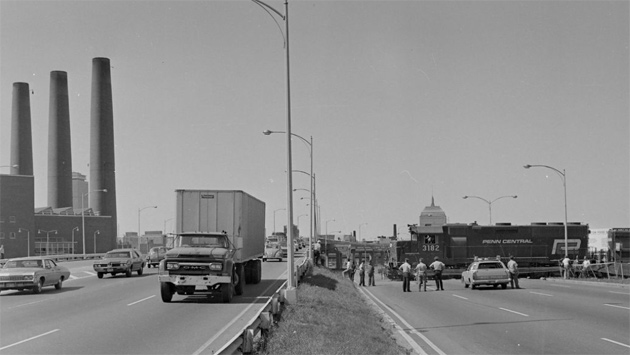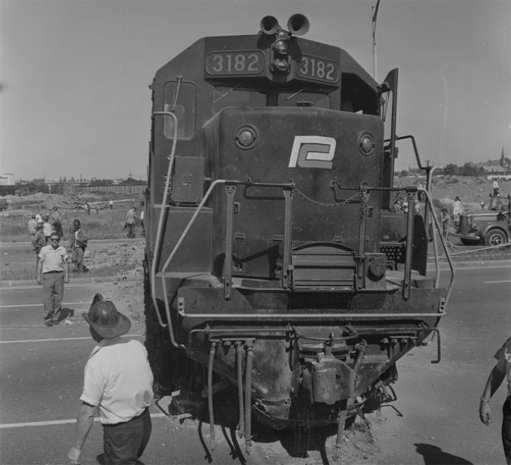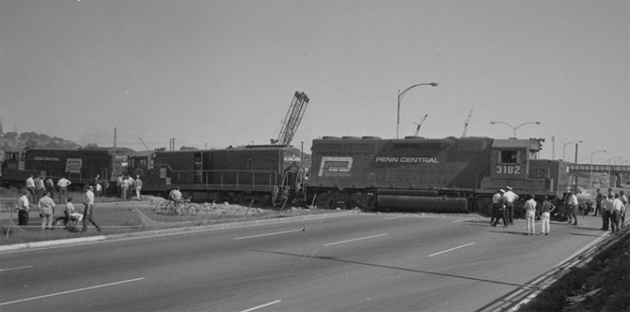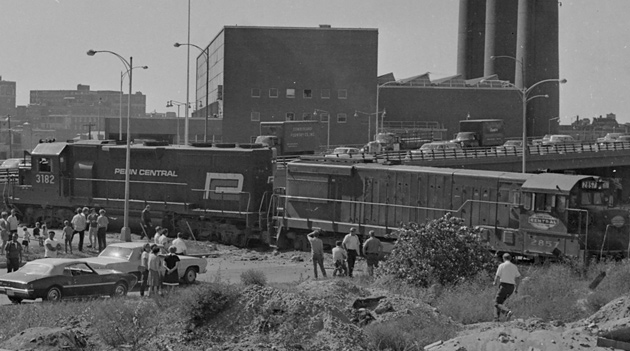The day some locomotives made a break for it on the Southeast Expressway

See it larger. From the BPL Brearley Collection.
Update: Lead locomotive still in service, in New Jersey.
Shortly before 3 p.m. on Aug. 21, 1969, a crew of Penn Central workers had just gotten three locomotives ready to haul freight from the Dover Street yard in South Boston to a yard in Albany, NY. The fuel tanks were full and the engines were on to await the "hostler," the yard engineer who would drive the locomotives over to the freight area to connect them to the cars for their trip.
But then, even though the brakes were engaged, the three locomotives began to move on their own. The hitched locomotives started traveling around a loop in the yard - today known as the MBTA's Cabot Yard.
As they picked up speed, the locomotives moved onto a short spur line that ended at a chain-link fence along Frontage Road and the Southeast Expressway just before the Mass. Ave. exit. Only with no one to stop them - state investigators later concluded the crew that had been working on the diesels panicked and jumped off - the locomotives got up to a speed of about 30 m.p.h before the lead diesel smashed through the fence and just kept going, across Frontage Road and onto the northbound side of the highway.
The first engine made it most of the way across the northbound lanes before it stopped, gouging out what the Globe reported were three-foot-deep grooves in the road. The second diesel came to rest on Frontage Road; the third, its connection to the second broken by the jostling, behind it.
See this comment for more details on what happened.
Amazingly, nobody was hurt in the crash, although coming as it did a couple of hours before the afternoon rush hour, it created immense traffic jams on both sides - northbound because police were diverting traffic at Neponset Circle, southbound because everybody was rubbernecking - it's not every day you see diesel locomotives sitting on the highway.
The Globe reports that a Penn Central crew was able to pull the third engine back onto the tracks from which it had come, but that to get the other two off the road, they had to first bring in some temporary tracks and use cranes to lift the 125-ton vehicles onto them before they could be wheeled back into the yard. The Globe quoted a Penn Central official as saying this had never happened before.
The Boston Public Library's Brearley Collection, which has thousands of Boston news photos from the 1920s through the 1970s, has a number of photos of one of Boston's lesser known oddball disasters:

The South Bay incinerator, at left, is now the site of the Greater Boston Food Bank.


The crash came at a time of considerable ferment in the railroad industry. Penn Central itself had only been formed the year before, when the marginally profitable Pennsylvania Railroad and the equally modestly profitable New York Central merged (ultimately, the new railroad failed spectacularly). The second engine in the crash, in fact, still had New York Central logos emblazoned on it:

The Dover Street yard originally belonged to the New York, New Haven and Hartford Railroad, which Penn Central acquired only a few months before the crash. Four months after the crash, the MBTA board voted to spend $7 million to buy the 40-acre Dover Street yard, which it still owns today for Red Line and bus operations, but under the name Cabot Yard. Dover Street, meanwhile, was renamed East Berkeley Street.
Photos used under this Creative Commons license.
Ad:

Comments
One of my bosses during the 1990s
(who has long since retired) had an aerial photograph of this accident in his office. It was in a wood frame with a plaque on it that read "Southeast Expressway - August 21st, 1969. Balanced Transportation."
Just to remind you Adam. The New Haven Railroad, which was not profitable by that time, was also part of the Penn Central merger. The ICC required inclusion of the New Haven as a condition of approving the merger. However, Penn Central management always treated the ex-New Haven portion of the railroad as an orphan child.
I bet it's this photo
From the Globe.
About the New Haven, you're right. But they didn't take control of the New Haven until several months after they'd eaten the New York Central from what I read.
Nope not that photo.
This photo was taken looking north, and showed all four locomotives in the consist, not just the one that ended up on the Expressway. As I recall, it wasn't a press photo, but was taken by a MassDPW (predecessor to todays MassDOT Highway Division) photographer.
Regarding the Penn Central merger, the Pennsylvania and New York Central merged in February of 1968. The New Haven merged with the Penn Central in December of 1968. The yard the locomotives escaped from was originally a New Haven yard, as the New York Central (Boston and Albany division) had their primary engine facilities at Beacon Park in Allston.
Dover Street to East Berkeley Street
Ann Street to North Street.
Templeton Street to Monsignor Patrick Joseph Lydon Way.
I love when the city thinks it change the downtrodden nature of an area by changing its name.
40 acres in South Boston for $7M? Today? North of $400M.
My father was caught in this traffic jam in his 67 Plymouth Fury.
inflation
$7 million in 1969 is almost exactly $50 million today.
Even so, buying land in Boston and waiting out would make you rich today. But that would also be a 50 year investment which you'd be paying taxes on the meantime.
Just putting your cash in an index stock fund and waiting just as long would be a better investment.
Olympics
You could also bid for an Olympic Games and then demand the city purchase it for you at a discount, like Fish and Shirley wanted to do with Newmarket.
Any idea what caused this?
Did they ever figure out what happened to set this Great Moments in Clusterflux in motion?
Somewhere out there ...
Is the answer.
Turns out ICC and FRA crash reports from 1969/70 are online, but they didn't investigate this one (because nobody died and nothing exploded, I bet).
The Mass. DPU did investigate it, as part of an overall review of the growing number of railroad derailments and crashes in the state (at a time when railroads were not exactly pouring money into maintenance), but I couldn't find that report in the online state archives.
The Globe wrote about the report, which came out in the spring of 1970, but they didn't discuss the cause of this particular crash, except to quote the then DPU commissioner as saying it could have been prevented if the crew hadn't jumped off the diesel in a panic but instead done whatever it is they should have done to stop the engines (I don't know, turn a key or something)?
The FBI was initially brought into the investigation over fears of sabotage (unions were not exactly happy with the way the merger was going) or vandalism, but apparently those were ruled out at some point.
Dead man's switch/pedal
Since the steam locomotive era, every railroad train -- steam, diesel, or electric -- has been required to have a switch or pedal in the cab, that the engineer is supposed to press, simply to indicate that yes, s/he is alive. Originally, the switch had to be depressed constantly. In more recent versions, it has to be pressed periodically, every minute or so, or within so many seconds of an alarm. Failure to press the switch within the required time interval causes the locomotive power to be shut off and the emergency brakes to be applied.
This applies also to rapid transit trains but not to streetcars (like the Green Line), which have different control systems, many of which achieve the same end by a different means.
Of course, the crews always think this is a pain, and sometimes it literally is, your limb gets sore from holding that button down for hours. So since the dead man's switch was invented, crews have devised ways to get around them -- a wedge or weight or something that can be used to press down on the button. As crews have gotten more inventive with their bypass devices, locomotive builders have gotten more inventive in designing the switches.
It's supposed to be a serious rules violation if a train engineer is found using, or even possessing, a device to bypass the dead man's switch. But in fact, it happens nearly all the time -- probably more than 99.9999% of the time.
Almost certainly, the investigation of this incident showed that one of the crew had used a device to bypass the dead man's switch, which allowed the locomotive to move without a live human seated at its controls. And that rules violation would be considered the cause of the accident.
There was a similar incident maybe 3 or 4 years ago on the Red Line, when the train operator got out of the cab and off the train, forgetting to remove the bypass device that he had placed on the dead man's switch. And then the train started moving, and became a runaway train, with passengers on board. [I'm not being sexist here; as I recall, this particular operator was indeed a he.]
Not quite. The Red Line incident happened
when the operator of the train intentionally overrode the "dead man's" feature on the controller in a very unconventional manner, apparently because the train wouldn't move when he tried to use the device in the normal manner. He then stopped and got out of the cab to reset a signal that had failed. Because the "dead man's" feature had been overriden, the train immediately took off once the signal cleared.
I am well aware that the NTSB has limited resources and cannot investigate every accident or incident in all transportation modes, the exception being for aircraft accidents - both commercial and general aviation, which they are mandated to do as part of the law that created the NTSB. However, it still bothers me that they didn't investigate the Red Line runaway train. For one thing, an investigation might have determined whether intentionally overriding the dead man's control was an isolated incident, or an action that was practiced by other operators as well due to the age and condition of the operators stands.
Tell me honestly...
Tell me honestly...
Why does it happen that when somebody posts a comment with "X happened, and Y was involved", you reply to them with "Yeah, X, but not quite - you gotta remember that Y was involved!"?
Because the involvement of Y is often more complex
than is often implied in the original post. In the case of the Red Line incident, as I understand it, the operator had to keep the Rube Goldberg dead man's bypass engaged when he got to the signal, otherwise the train would have stopped cold. As such, I seriously doubt he foprgot he had rigged the deadman's control when he left the cab to reset the signal.
As i noted, given the age of the equipment, it's likely that this was not an isolated incident. With respect, these are precisely the sorts of things that investigations by independent agencies will likely uncover.
That's not exactly right
That's not exactly right either.
https://www.wbur.org/news/2016/03/01/mbta-runaway-red-line-train-report
The Red Line driver wrapped the microphone cord around the deadman handle so he could put on his gloves while driving. And he forgot to remove the cord afterward. That part had nothing to do with malfunctioning equipment.
Later on the train failed to detect a signal code to proceed. He got permission to press the bypass switch, which is outside the train. He did not set the brakes, another rule violation. Then due to the rigged handle, the train immediately took off. And it wouldn't obey any further automatic stop signals because of the bypass switch. They had to cut the power to stop it.
Cause of Derailment
The Locomotives were not under the control of a “Train Crew”, but were being inspected by 2 Electricians. They started the leading locomotive with the throttle engaged. This could not happen except they had a safety feature defeated while performing work. Both men jumped from the moving train and the person in charge of the manual switches shouted out a warning over a local intercom that their was a “Run Away” coming out of “Cork Point” (Dover Street Yard).
The Operator in the South Bay control tower made a split second decision to route them toward Frontage ( aka Front ) Yard. That probably saved many lives because the Locomotives would have gone around a Loop Track and unimpeded into South Station Terminal.
Electricians had been working
Electricians had been working on them and when they started to move (thinking the engineer was taking them) they bailed off.
If it had been a passenger train ...
It might have gone something like this:
Or this (somewhat based on a real-life event)
Gare de l'Ouest 1895
The building now houses the Musee d'Orsay - a must visit if you are in Paris for even a day!
Different station
Musée d'Orsay was Gare d'Orsay, which was not built until after the 1895 crash.
Gare Montparnasse (née Gare de l'Ouest), which the crash occurred, is still in use today.
Musée d'Orsay does have a photograph on display from the crash.
Boston connection
Musée d'Orsay has an interesting connection with Boston railroads.
Among the museum's most famous works is a portrait of Anna McNeill Whister, by her son, James McNeill Whistler.
Robert Gibbs McNeill and George Washington Whistler were pioneering civil engineers who designed some of America's first railroads, including the Baltimore & Ohio, the Boston & Lowell, and the Boston & Providence. Whistler fell in love with McNeill's sister, Anna, and married her. Their first son, James, was born while the couple was living in Lowell in July 1834. Their son painted the portrait of his mother in 1871.
So it's quite fitting that the portrait of Whistler's Mother should be displayed in a railroad station.
On WBZ radio
Dave Maynard was on the air and threw it to Joe Green in the traffic copter for a routine update.
Joe was doing his usual no-nonsense report and then said 'and there is a Penn Central locomotive blocking the northbound lanes of the expressway.
Maynard cracked on the air 'Joe, have you been drinking?'.
Perhaps Not Joe
But, Dave...…...
Also Soldiers Field Road?
I remember from approximately the same era, a locomotive escaping the switching yards by the BU Bridge and running halfway across Soldiers Field Road, but my Google-fu is failing me and I can't find a picture or a reference to it?
As big as the Dotcom bust in 2000, but not quite 2008
Penn Central was a major US business organization with a lot of debt in the form of "commercial paper", which is essentially a short term unsecured loan. The bankruptcy filing in June 1970 caused a panic in the industry. Goldman Sachs was at the center of the action. Is that surprising to anyone? Why, isn't Goldman Sachs where Joe Kennedy II still has just shy of $3 Million on deposit for his zombie PAC?
https://www.goldmansachs.com/our-firm/history/moments/1970-penn-central-...
https://www.bostonglobe.com/metro/2019/09/06/all-family-joe-kennedy-coul...
I'll bet I was the only one here
who was actually stuck in that mess. Coming back from Nona's in Dedham.
4 hours we sat there. Three kids and a newborn and my old man just flipping channels on the AM radio in our Chrysler station wagon.
Good times?
did this line
did this line service the waterfront docks? Its somewhat surprising that no train lines go to the intermodal yard in southie. They have to get trucked to worcester. Seems like a huge waste of gas and trucks on the road.
This happened between the
This happened between the Fairmount Line overpass and the South Boston Bypass Road (as we would describe them today).
https://www.google.com/maps/@42.3326785,-71.0627478,406m/data=!3m1!1e3?hl=en
https://www.google.com/maps/@42.332566,-71.0627698,3a,60y,355.9h,87.61t/data=!3m6!1e1!3m4!1sSQsuXHbXbxWbnZQ13lX3Fw!2e0!7i16384!8i8192?hl=en
I'm sure trains could get from there to Southie back then, even as they technically still can get from there to the single remaining track remaining beside the Bypass Road today. I just don't know how direct it might have been back then. Today's configuration of tracks and buildings means a train in that area would have to go in towards South Station to switch to an outbound Braintree/Greenbush track, and maybe even go past the Bypass Road to reverse direction into the remaining track.